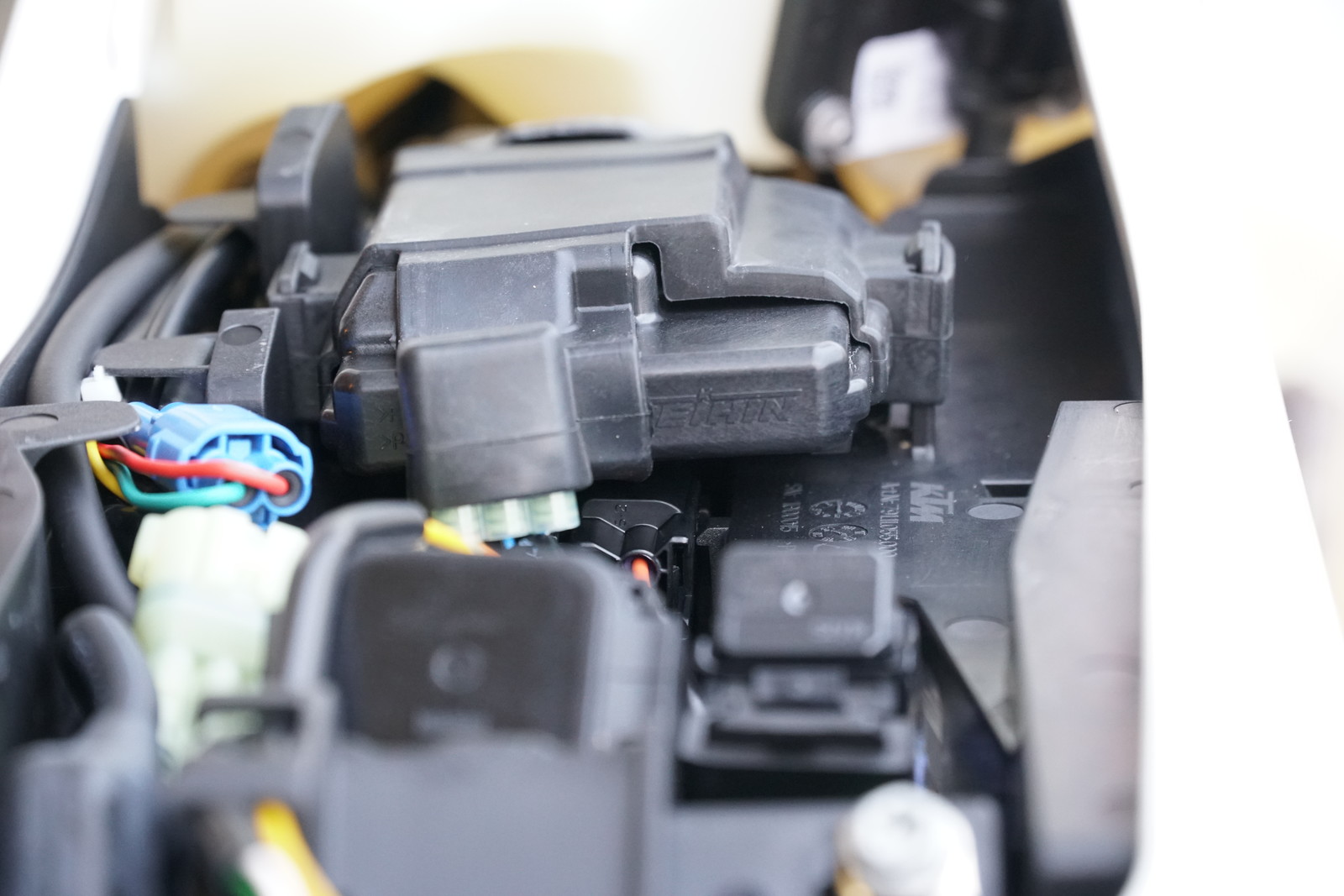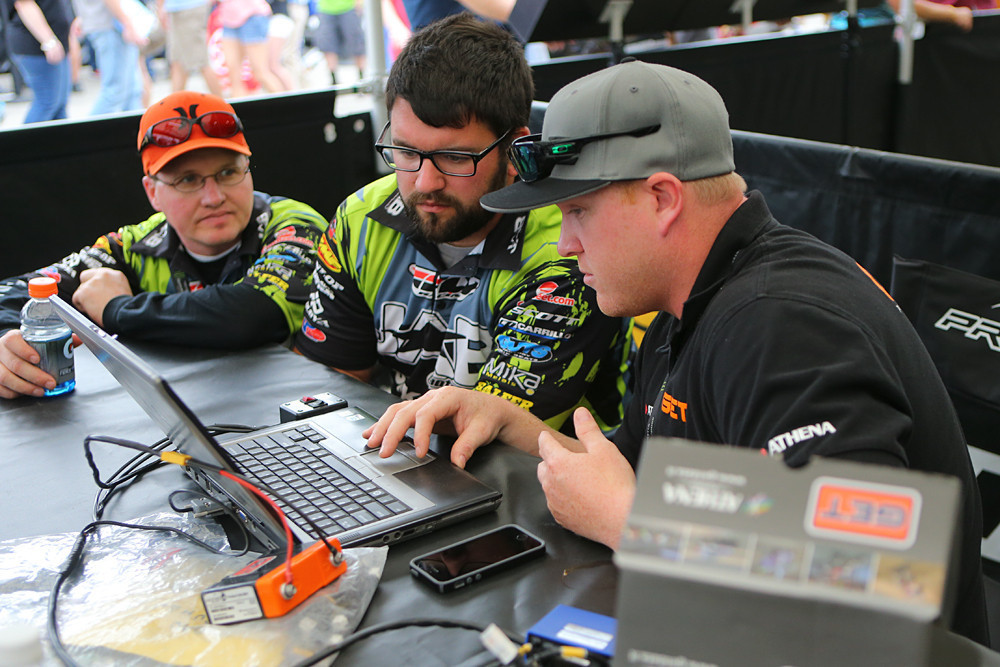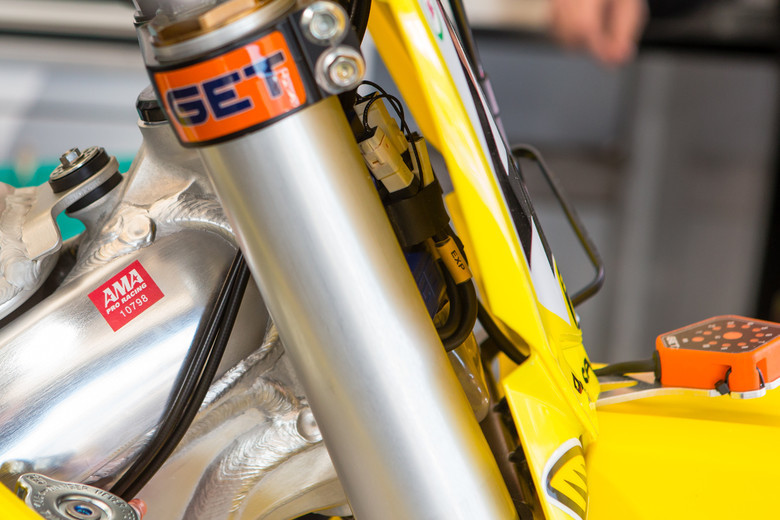When did we start living in the future? The change happened so fast, we barely even noticed. One moment we’re swapping out jets, adjusting needle clips, and fiddling with screws, and the next moment we’re using WiFi to link our smartphone to our bike and changing maps in real-time. That’s nuts. Just a few years ago, this was a crazy idea. Ten years ago, this would seem like pure fantasy since EFI on dirt bikes and smartphones where just barely gaining traction.
That being said, here we are with fuel injectors and spark plugs being controlled to a staggeringly precise degree by, basically, a small computer on your dirt bike. But how did we get here? With the ability to modify maps and move the power where we want, are other physical engine and exhaust changes going to become less important? With apps, are couplers going to fade away? Is testing all dyno or at the track? We had a whole lot of questions about ECUs and dirt bike electronics, and decided to reach out to experts at Vortex Ignitions and GET to talk about the future and past of ECUs, and how the whole thing works.
We talked with Richard Muurling, Managing Director of Vortex Ignitions; and Dan Truman, Brand Manager of GET USA. Both GET and Vortex have long histories in the electronic bike tuning game and collectively are the go-to aftermarket ECU suppliers used in professional racing today.

In simple terms, what is the difference between a CDI, Fuel Control, and ECU?
Muurling/Vortex: CDI (Capacitor Discharge Ignition) is typically used on the non-EFI (Electronic Fuel Injected) and carbureted motorcycles. Fuel controller commonly refers to a “piggyback”-style system that intercepts some of the signals between sensors and the standard ECU and tricks the standard ECU to give different outputs to change the fuel trim. This is not a method we are involved in anymore and we only made a one of these for the early ATV’s before we fully developed the ECU product. The piggyback systems are limited in what they are able to change, and therefore miss out on many of the gains of an full ECU. ECU stands for engine Control Unit. As the name stated this is the computer that controls all of the engine’s ignition timing, fuel mapping and fuel phasing (or angle of injection). With the ability to program all the functions of an ECU then there are more gains to be made, not just in outright performance but also in response and rideability. This gives the ability for race teams to customize the power delivery.

Truman/GET: This is a funny thing. CDI stands for Capacitive Discharge Ignition and refers to the nature of the ignition coils widely used on initial carbureted two-strokes engines where Capacitive Discharge Ignition was the right solution for both spark energy and the charge circuit coming from the generator on system without a battery. The electronic unit controlling the ignition took the name of CDI, but it was (and is) also an electronic control unit for CDI ignition. Another type of ignition coil is the TCI or IDI (Transistor Controlled Ignition or Inductive Discharge Ignition). With the introduction of the Electronic Fuel Injection (EFI) the electronic control module finally took its name of ECU. In a few words an ECU is an electronic device that controls a multitude of sensors and actuators to calculate the correct amount of Fuel and the optimum spark advance under all working conditions.
Could you give me a little history on Vortex/GET? How you started, the first bikes you guys started working on, that sort of thing?
Muurling/Vortex: This is a long and involved story, but I will give you the short version of how we started. Back in the ‘80s in Australia I was working for the automotive industry in R&D of a German company, VDO, developing dash instruments clusters for Ford, GM, and Toyota ,and this is where I developed some of my skills in automotive-specific electronics and manufacturing quality. Since a young age I have raced and ridden dirt bikes in mainly off-road endurance racing, and now trail riding and being a professional test rider. Our Enduros back in the ‘80s were always tough events with lots of mud and tight trail times. In the early ‘90 I was riding a modified YZ250 two-stroke which was a real weapon, but sometimes hard work in the tight and technical events. I got to thinking if you had the power of an XR250 in the tight going, and then the power of the YZ250 in the more open and faster special tests, life would be easier and times would improve. I was pretty sure I could achieve this by modifying the ignition timing so with the help of my work colleague at the time, and now business partner, Howard, we set about developing the world’s first Dual Curve Ignition, which could be switched on the fly via the handlebar switch. I tested this in races in the early ‘90s and was amazed by what we could achieve to customize the power delivery. We started the business in my garage in the early to mid-90’s and we have progressed to where we are today as a company, leading the world in programmable ECU products for the off-road market. Like many successful businesses this was driven by my passion for dirt bikes and this sport of off road racing. I am sure without that passion we would never have succeeded, as there are easier ways to make a living.
Truman/GET: GET is a combination of experiences, which began separately before EFI was introduced in the dirt bike world. The original GET team was working on EFI transformation of a Japanese 450 bike while its actual Technical Director was working on the development of Aprilia 450/550 SXV/RXV. The combination of the two thanks to Athena created GET as we know it today.
When you look at stock dirt bikes what is the first step? Can you "see" their maps? Are these baseline or do you just start from scratch?
Truman/GET: No, we don’t “see” their map, but in case we need to, we can measure what “they do.” But in general we start from scratch on every application. Of course part of the work done on last year’s bikes can be used as baseline for the new models. Being involved in OEM supply, our structure gives us all the instruments to create the calibration from scratch.

I'm assuming that OEMs have to err on the side of durability and be conservative with their stock maps. Is this the case or are they closer to the "limit" than we think?
Truman/GET: This is true for some street applications where mileage and durability are key factor, but with dirt bikes they are closer to the limit, with some differences between manufacturers. But overall, dirt bikes are much closer than other applications.An ECU controls ignition timing and fuel.
To chase increased performance do you start with one over the other or are you manipulating both together?
Truman/GET: This answer is very complex, but here is the short version. First, startability is a key factor especially for the kickstart bikes and involve low and high temperatures. Then a rough and conservative fuel calibration is needed for better spark advance calibration. Finally, both are manipulated together since performance is not only max power but also rideability.
What is your view of the balance of performance and durability?
Truman/GET: As with every application, it mostly depends on the use of the engine. The shorter the time between engine rebuilds, the closer we can push the calibration to the limit. This balance really depends on the target for the application. Race engines can push very close to the limits. Moreover, the most important thing is the control [rideability]...not only the power, so gains can be made when many sophisticated control functions are available. That’s why max power loses with respect to control.

What is your view of exhaust pipes? Are they necessary today with our ability to play with the mapping so much?
Muurling/Vortex: I believe with the sound restrictions, there is less ability for the pipe manufacturers to make the kind of difference they used to.
Truman/GET: The most important focus for an exhaust pipe is driven by the noise controls limits. The ability of manufactures to increase the performance of a pipe and stay within noise control limits makes the difference. That said, most calibration works on a wide range of exhaust system and as fine as the calibration is, you’ll see bigger performance gains.
In your opinion, should a bike be remapped after an exhaust pipe installation, or any engine mod for that matter?
Muurling/Vortex: It really depends on the bike and the level of changes.
Truman/GET: In principle, yes, but it all depends on target performances. In other words it’s the same as, do people need to adjust their pant length? Usually they fit a certain range of people and there is no need to adjust them. But if you are going to dress up for a formal dinner and want to look as good as possible...
What have you learned working with race teams?
Muurling/Vortex: Racing pushes everything to the limit and I guess that is why more things happen when you are racing rather than just testing. So racing is always the best way to find the best and also problems associated with a product.
Truman/GET: Working with racing teams is always a challenge, and it pushes our development capability higher and higher. Providing them [race teams] with the most advanced customization capability forces us to always keep in mind the maximum flexibility when designing the calibration strategies. Things might happen or change in a very short time. This also benefit other users who want to dig deep in the calibration process.


What does the average rider need to know about ECU mapping that they don't?
Muurling/Vortex: We have spent many years learning to develop tuning methods specifically for dirt bike applications. One of those lessons is that you cannot get the best out of tuning just on the dyno and need to also track test or at least have had many years experience to understand the relationship between dyno test results and the application on the track. This is case with all motorsports but even more so with off-road applications. In the early years, I would generally spend an equal or greater amount of time on track testing as on the dyno, and often what we did on the dyno would be changed when track testing. The dyno is a great tool and definitely necessary with EFI bikes, but it is only the starting point. I believe this methodology is what differentiates our company from others.
Truman/GET: This depends rider-by-rider and their own sensibility to work on development of the bike. As with everyone, some riders have an understanding and some haven’t. As much as a rider can drive the tuner in the right direction, the closer to his needs the calibration can be.
In the future, do you see all bikes being like the YZ-Fs with power tuner apps? Also, what do you think of this app and how it works?
Muurling/Vortex: Yes, I guess this is the way of the future for everything. For example, smart house technology. However, often giving the average guy without the experience necessary to make good tuning decisions can limit progress for that racer or team. It is like anything that in the majority of applications it is best left to the experts. We have and old expression here; “shit in, shit out.” However if these kind of apps can help a user diagnose a problem then that has real value for the consumer.
Truman/GET: GET introduced tuner app on its ECU starting 2013. No other comments needed.




View replies to: ECU 101: Tuning, Mapping and the Future
Comments